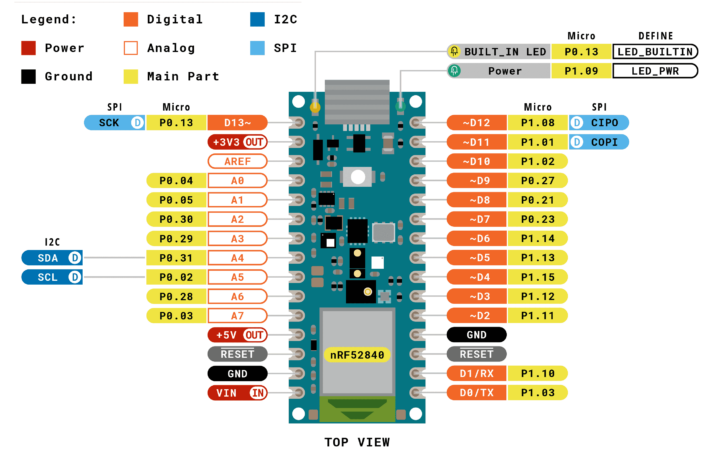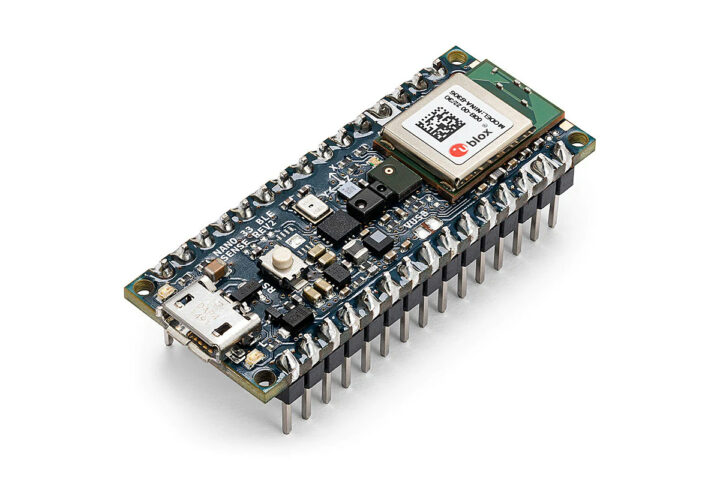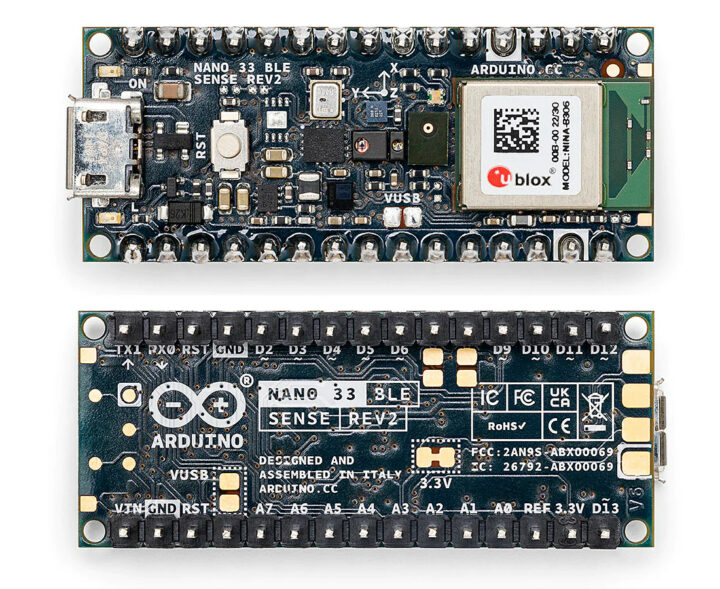Arduino Nano 33 BLE Sense Rev2 is a new revision of the Nano 33 BLE Sense machine learning board with basically the same functionality but some sensors have changed along with some other modifications “to improve the experience of the users”.
The main changes are that STMicro LSM9DS1 9-axis IMU has been replaced by two IMUs from Bosch SensorTech, namely the BMI270 6-axis accelerometer and gyroscope, and the BMM150 3-axis magnetometer, a Renesas HS3003 temperature & humidity sensor has taken the place of an STMicro HTS221, and the microphone is now an MP34DT06JTR from STMicro instead of an MP34DT05. All of the replaced parts are from STMicro, so it’s quite possible the second revision of the board was mostly to address supply issues.
Arduino Nano 33 BLE Sense Rev2 (ABX00069) specifications:
- Wireless Module – U-blox NINA-B306 module powered by a Nordic Semi nRF52840 Arm Cortex-M4F microcontroller @ 64MHz with 1MB Flash, 256KB
RAM, Bluetooth 5.0 LE connectivity - Expansion – 2x 15-pin expansion headers with up to 14x GPIO, 13x LED pins, 5x PWM, 8x analog inputs, UART, I2C, SPI, reset, and power signals (+5V, +3.3V, GND, Vin, AREF, …)
- Sensors
- Bosch SensorTech BMI270 3-axis accelerometer + 3-axis gyroscope
- Bosch SensorTech BMM150 3-axis magnetometer
- MP34DT06JTR microphone
- APDS9960 gesture, light, proximity sensor
- LPS22HB barometric pressure sensor
- Renesas HS3003 temperature & humidity sensor
- HW Security – Microchip ATECC608A crypto chip
- Misc – Reset button
- Power Supply – 5V via micro USB port and 5 to 18V via Vin
- Dimensions – 45 x 18 mm compatible with the original Arduino Nano
- Weight – 5 grams

Other changes include the replacement of the power supply chip (MPM3610 for MP2322), the addition of a VUSB soldering jumper on the top side of the board, and new test points for USB, SWDIO, and SWCLK. On the software front, you’ll only need to change the libraries to Arduino_BMI270_BMM150 for the new IMUs and Arduino_HS300x for the new temperature and humidity sensor, and after that, I understand your existing Arduino code should work without further modifications.
Arduino provides detailed documentation for the new board with tutorials, hardware design files (Altium), a support forum, and so on. Not all Arduino boards are open-source hardware, but the Nano 33 BLE Sense Rev2 together with the Make Your UNO Kit and a Screw Terminal Adapter for Nano are the three hardware products that were open-sourced in 2022 according to Arduino’s Open Source Report 2022.
The Arduino Nano 33 BLE Sense Rev2 sells for $40.50 / 38.21 Euros without headers and $43.50 / 41.04 Euros with headers. That’s quite a steep price increase over four years since the original Arduino Nano 33 BLE Sense sold for $29.50 without headers and $31.50 with headers at launch in May 2019, but that’s just the world we live in now…

Jean-Luc started CNX Software in 2010 as a part-time endeavor, before quitting his job as a software engineering manager, and starting to write daily news, and reviews full time later in 2011.
Support CNX Software! Donate via cryptocurrencies, become a Patron on Patreon, or purchase goods on Amazon or Aliexpress






“U-blox NINA-B306 module powered by a Nordic Semi nRF52480 Arm Cortex-M4F” should be nRF52840
You are technically correct, which is the best type of correct (yes, stolen from Futurama). While most won’t notice the discrepancy it should technically be “Nordic nRF52840 MCU, built around 32-bit ARM Cortex-M4 CPU operating at 64Mhz” but honestly I’m unsure why would want to pay more for this than getting the Seeed Studio XIAO nRF52840 Sense. It is cheaper and smaller but doesn’t have 3 of the built in sensors this one does so this may be a better option for anyone who needs all those sensors in one module without having to add the 3 extra sensors this one has compared to the Xiao. That and this one appears to have a few more GPIO’s but I didn’t count and compare.